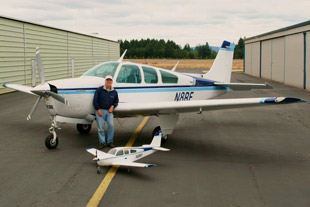
Illustration: John Holm
America’s state legislative season has begun—speak up
Lawmakers in all 50 states are busy trying to meet the needs of their constituents, balance their state budgets—and in the process, fund the programs and projects that are in line with their priorities. In the midst of these efforts, the interests of different groups and businesses all will ebb and flow in the tide of legislative momentum. Throughout the hustle and bustle, however, a call to a senator or representative from an AOPA member from their district can bring focus to the needs of local aviators: AOPA members make a difference. That is why it is so important for you to engage with your state legislators on a regular basis, and become familiar with the lawmakers who are making decisions affecting your area.
Know your legislator—become familiar with who is representing you, and make sure they become familiar with you as well. People are more likely to listen to a friend than a stranger. Legislators are the same way—the more familiar they are with you, the more likely your opinion will influence their decisions. Contact your legislator from time to time with a good word or some update on your business or personal ventures, rather than contacting your legislator only when you have trouble.
Reach out to your AOPA regional manager if you have questions or concerns. They often are in contact with the legislative leadership in your state and can help you communicate and become more familiar with your state’s legislative process.
Your AOPA state advocacy team will impact hundreds of pieces of legislation this year, but it’s you who makes a difference.
66% of AOPA members believe the political environment is “not so good” for GA.
Action in the states
State by state
Alabama: AOPA Regional Manager Bob Minter is working with state Rep. Chris Sells to introduce an amendment to the Alabama Code that will clarify liability for private landowners whose property is used as an airfield or for aviation activity. Alaska: The current version of the Anchorage/Fairbanks Terminal Area Chart shows redefined CTAF area frequencies for the Matanuska and Susitna valleys north of Anchorage. The new frequencies change the CTAF assignments of almost 80 individual airports and assign frequencies to 36 airports that didn’t have them. Arizona: Regional Manager John Pfeifer discussed the recent FAA Aviation Fuel Tax Revenue Policy and its impact on GA with a key leader from the Arizona Department of Transportation Aeronautics Group. Arkansas: AOPA President Mark Baker will host an AOPA Pilot Town Hall in Bentonville on March 11. California: Regional Manager John Pfeifer met with state senators and transportation officials to represent the GA perspective on critical issues, including aeronautics programs and funding. Colorado: Regional Manager David Ulane represented AOPA at the Colorado Airport Operators Association’s annual reception in Denver, where he met with aviation advocates, pilots, airport managers, legislators, and aviation officials. Connecticut: Regional Manager Sean Collins met with officials from the Connecticut Airport Authority at Groton-New London Airport to discuss ways to boost competitiveness. Delaware: The Delaware Wing of the Civil Air Patrol hosts its annual conference at Dover Air Force Base March 28. The event includes educational seminars for the wing’s more than 500 members. Florida: AOPA supports legislation that would save members money by providing a sales-tax exemption for maintenance on aircraft with a gross takeoff weight of less than 2,000 pounds. Georgia: AOPA is co-sponsoring a legislative event hosted by Georgia’s Department of Economic and Community Development Center for Innovation in Aerospace. Hawaii: AOPA contacted the leadership of Hawaii’s Senate Ways and Means Committee and House Finance Committee to express concern over the state Department of Transportation’s management of airport funding, hangar leases, infrastructure, and other GA issues. Idaho: AOPA and ASN volunteer Greg Gfeller will monitor land use discussions at the Coeur d’Alene airport, where proposed land use plans for property surrounding the airport could impact future improvements. Illinois: AOPA met with Chicago-area airport advocates to discuss the value and importance of GA to the region. Indiana: AOPA worked with area pilots to make the case for GA after the pilots expressed concern that a local airport authority was trying to eliminate GA hangars. Iowa: Regional Manager Yasmina Platt will teach a Pinch-Hitter safety seminar as part of the Iowa Aviation Conference. Kansas: AOPA took part in Kansas Aviation Day at the state Capitol in Topeka. Kentucky: AOPA Regional Manager Bob Minter attended the Kentuckians for Better Transportation annual conference to bring the GA perspective and meet with state legislators. Louisiana: AOPA is working with the Louisiana Agriculture Aviation Association and other GA groups to promote legislation to mark and register meteorological evaluation towers. Maine: AOPA Regional Manager Sean Collins brought the GA perspective to state leaders in meetings of the Maine Aeronautical Advisory Board and the Maine Aviation Business Association. Massachusetts: AOPA Regional Manager Sean Collins served as a guest speaker for the Atlantic Aviators and the Minute Man Air Field Annual Kickoff party. Michigan: Growing aviation and increasing awareness through STEM programs in schools were among the topics as AOPA participated in a meeting of the Michigan Aeronautics Commission’s General Aviation Subcommittee. Minnesota: AOPA is working with local pilots, airport supporters, and the Lake in the Woods County board of commissioners to push for the development of a new GA airport in Angle Inlet. Mississippi: Tupelo Airport Manager Josh Abramson is leaving his position to become the director of Easterwood Airport in College Station, Texas. Missouri: Two bills to include aviation activities in Missouri’s recreational use statute have been filed and AOPA is working with lawmakers to reconcile the two. The legislation will help increase recreational aviation activity, protect the owners of private airstrips from liability, and stimulate the economy. Montana: AOPA attended the annual Montana Aviation Conference in Missoula. The conference brought together airports, pilots, aircraft maintenance professionals, and public officials. Nebraska: State Senator Bob Krist was inducted into the Nebraska Aviation Hall of Fame. Krist has been a friend to GA in the state, supporting pro-GA legislation. Nevada: AOPA is supporting state Senate Bill 93, which would provide tax abatement for property and sales-and-use taxes relating to aircraft ownership, maintenance, repair, and testing. New Hampshire: AOPA Regional Manager Sean Collins represented GA interest at the Granite State Airport Management Association meeting. New Jersey: City leaders are considering changes to hangar leases and land use at Ocean City Municipal Airport. AOPA is providing guidance and resources. New Mexico: AOPA, the state Department of Transportation, FAA, airport managers, and other GA groups are developing a new aviation system plan in the state. New York: Preserving access to East Hampton Airport has been the topic of multiple meetings between AOPA Regional Manager Sean Collins and industry and aviation groups. North Carolina: AOPA is offering to provide assistance to Gov. Pat McCrory’s North Carolina Aviation Development Task Force as it works to develop recommendations that will strengthen aviation programs. North Dakota: AOPA met with state legislative leaders regarding a bill that would affect the state’s aircraft registration fee. Ohio: When a Cleveland-area flying club found itself caught in a dispute over hangar space, it turned to AOPA for help, and the association worked with all parties to find a successful resolution. Oklahoma: Gov. Mary Fallin signed the Oklahoma Aeronautics Commission’s emergency rules to register and mark meteorological evaluation towers in the state. Oregon: AOPA supports pending legislation that would add aviation activities to the state’s recreational use statute. It would limit liability for private airstrip owners who make their facilities available for use by the public, giving pilots access to new airstrips around the state. Rhode Island: The Rhode Island Aviation Hall of Fame plans to develop a family attraction around the retired aircraft carrier USS John F. Kennedy. South Carolina: AOPA is working with the South Carolina Aviation Association to introduce and support legislation that would provide a sales tax exemption on aviation maintenance. South Dakota: AOPA’s Bryan Budds is taking part in the 2015 South Dakota Airports Conference in Sioux Falls. Tennessee: AOPA and the Tennessee Aviation Association will co-sponsor a legislative event on Capitol Hill in Nashville. Texas: Regional Manager Yasmina Platt gave presentations to EAA Chapter 12 and the North Central Texas Council of Governments’ Air Transportation Technical Advisory Committee, took part in an NBAA event in San Antonio, met with board members from the Alamo City Chapter of Women in Aviation, and met with the City of San Antonio’s department of aviation to discuss plans for Stinson Airport’s 100th anniversary celebration. Utah: AOPA Regional Manager David Ulane briefed more than 100 participants in a Runway Safety Summit at Salt Lake Valley about tools to help reduce runway incursions, spoke at a Leading Edge Aviation pilot dinner, and met with AOPA members at Ogden/Hinckley Airport. Virginia: Chesterfield County Airport-Richmond Executive Airport plans to increase the length of its runway from 5,500 feet to 6,300 feet by 2019. Vermont: Bennington has received a new Civil Air Patrol airplane to be used in search and rescue operations and aerospace education. Washington: AOPA President Mark Baker provided the keynote address at the Northwest Aviation Conference in Puyallup. West Virginia: AOPA is working with property owners and legislators to boost support for a measure that would limit the liability of landowners who allow recreational aviation use of their property and private airstrips. Wisconsin: AOPA Regional Manager Bryan Budds will take part in the Wisconsin Aviation Conference in LaCrosse. Wyoming: Rawlins native Glenn G. Larson is the latest inductee into the Wyoming Aviation Hall of Fame. He earned four Distinguished Flying Crosses and nineteen Air Medals during his combat service as a fighter pilot in Vietnam, and later was awarded the Legion of Merit.
Maryland: AOPA opposes a plan to build a hotel near College Park Airport. The hotel would be 35 feet taller than the maximum allowable height set by the FAA, and AOPA is concerned it would represent a collision hazard.
Pennsylvania: AOPA is working with the Department of Economic and Community Development to share the good news that the state sales tax exemption on aircraft maintenance passed in 2013 has boosted aviation activity and the state’s economy.
AOPA Action: Airport Support Network
Airport advocate
 When Portland-Hillsboro (Oregon)Airport Support Network volunteer Bob Flansburg (HIO) was encouraged to sign up for the ASN program, he thought, “Of course!” That was 14 years ago and Flansburg is a fierce advocate for his fellow pilots and the airport. For many years it was a quiet role, but fast-forward to the present and Flansburg is very busy. An anti-airport group has waged numerous attacks on Hillsboro and Flansburg is always there to refute its claims. He works tirelessly with the airport stakeholders to make sure the airport remains in a positive light with the local community. Eight years ago the airport sponsor began its long-range planning and, with the desire to have community input, created the Hillsboro Aviation Roundup Exchange (HARE). HARE is a diverse group of participants from the local community, Port of Portland employees, pilots, government appointees, and local businesses. Flansburg sits on the noise reduction and mogas availability subcommittees. Additionally, he has helped move along the parallel runway project, which is set to open soon.
When Portland-Hillsboro (Oregon)Airport Support Network volunteer Bob Flansburg (HIO) was encouraged to sign up for the ASN program, he thought, “Of course!” That was 14 years ago and Flansburg is a fierce advocate for his fellow pilots and the airport. For many years it was a quiet role, but fast-forward to the present and Flansburg is very busy. An anti-airport group has waged numerous attacks on Hillsboro and Flansburg is always there to refute its claims. He works tirelessly with the airport stakeholders to make sure the airport remains in a positive light with the local community. Eight years ago the airport sponsor began its long-range planning and, with the desire to have community input, created the Hillsboro Aviation Roundup Exchange (HARE). HARE is a diverse group of participants from the local community, Port of Portland employees, pilots, government appointees, and local businesses. Flansburg sits on the noise reduction and mogas availability subcommittees. Additionally, he has helped move along the parallel runway project, which is set to open soon.
AOPA to DOT: Time to act on medical reform
It has been nearly nine months since the Department of Transportation began a planned 90-day review of the FAA’s proposed medical reform rule, and AOPA members and the general aviation community are frustrated by the department’s inaction. The standard, which would allow some pilots to fly recreationally without obtaining a third class medical certificate, has been in use since 2004 when the FAA adopted the sport pilot rule.
“The evidence is clear: allowing pilots to fly without going through the third class medical process is safe,” AOPA President Mark Baker said. “The FAA’s proposed rule would simply extend this standard to more pilots flying more types of small aircraft.”
Medical reform has the support of more than 180 bipartisan members of Congress, who co-sponsored legislation known as the General Aviation Pilot Protection Act that would have allowed thousands more pilots to fly without obtaining a medical certificate.
Allowing reform to move forward will save time and money for pilots and the federal government, while bolstering GA—which contributes $150 billion to the economy and supports more than 1.2 million jobs. AOPA estimates that medical reform, as proposed under GAPPA, would save pilots $24.6 million every year. A conservative estimate also shows an annual savings of $1.9 million to the FAA.
“Our members, the GA industry, members of Congress, and the American people are frustrated with our government’s inability to move efficiently and effectively on issues that will improve safety, save money, and help create jobs and support local economies,” Baker said. “On behalf of our members and the aviation community, we must ask—when will the DOT allow third class medical reform to move forward? The time to take action is now.”
AOPA Foundation
Donate your airworthy airplane to the AOPA Foundation: Bypass the hassle of selling and gain a tax benefit, while fueling GA’s future with your donation.
Air Safety Institute
Could you handle a survival situation?
Get the experts’ tips on survival preparedness
 You’ve just made an unplanned, off-airport landing. Thanks to your training you were able to calmly cope with a developing in-flight emergency and successfully land the airplane. But now what? Have you been adequately prepared for what happens next? Can you reach out for rescue and endure the elements until help arrives?
You’ve just made an unplanned, off-airport landing. Thanks to your training you were able to calmly cope with a developing in-flight emergency and successfully land the airplane. But now what? Have you been adequately prepared for what happens next? Can you reach out for rescue and endure the elements until help arrives?
A little knowledge on what to do after a forced landing can go a long way. In the Air Safety Institute’s Survive: Beyond the Forced Landing video (www.airsafetyinstitute.org/survivalvideo) and Safety Advisor (www.airsafetyinstitute.org/survivaladvisor), aviation experts share what actions you can take to keep your passengers and yourself safe until help arrives. Among their advice are tips on survival kit essentials and how you can reduce the time it takes to get found. Learn why you and your passengers should be dressed to match the climate and terrain you will be overflying, in order to be prepared for conditions other than those expected at your departure and arrival points. As you might imagine, increasing your chances of a post-crash survival start with proper flight planning. Watch Survive: Beyond the Forced Landing to learn about the single most important thing to do to improve your prospects of being found, and download the publication for more tips, a priority checklist, and advice on how to build a basic two-person aviation survival kit. Round out your survival skillset with additional information found in ASI’s Survival Safety Spotlight.
Video and publication made possible by the Canadian Owners and Pilots Association and the Donner Canadian Foundation.
 CFI to CFI newsletter wins prestigious award
CFI to CFI newsletter wins prestigious award
The Air Safety Institute’s flight instructor newsletter brought home Folio’s 2014 Eddie Award for best standalone digital magazine in the Association/Nonprofit category.
Check out the latest edition for an amusing story of an excited flight cadet’s first experience in a T–33 Shooting Star, learn about a new take on how go-arounds should be taught, and ponder this question: Should you retract the flaps before or after setting takeoff power during a touch and go? Share your thoughts in the newsletter’s comment section.
New! ASI Winter seminar: ‘After the crash: Surviving an aircraft accident’
Bust the myths and learn the facts. Visit the website for dates and locations near you.
Just the cold facts, ma’am
There’s no such thing as a “little ice,” so plan ahead and allow extra time to remove all frost, ice, and snow clinging to the surfaces of your aircraft before you attempt to fly. You may get away with a wintry mix hugging your car, but not your airplane. To get airborne safely, follow the simple steps found in the Air Safety Institute’s Cold Facts: Wing Contamination Safety Advisor. It has some great tips on how to safely and carefully clean snow and ice off the airplane, including how you can make the process as comfortable as possible.
For more information: www.airsafetyinstitute.org/coldfacts_advisor
Products and Services
Renter’s insurance: Do I need it?
What’s the difference between a named pilot and a named insure? As the terms suggest, specific persons may be identified as approved pilots, or as insured persons on an aircraft insurance policy.
Being listed on an aircraft owner’s insurance policy as a named pilot does not eliminate the need to have your own liability coverage. If an accident or other covered occurrence takes place while you are operating the aircraft, your status as a named pilot “would not exclude” the owner’s coverage from being applicable to the occurrence. As the pilot of a non-owned aircraft, you could still be a target for subrogation by an injured party seeking damages. (Subrogation means that you, as renter, could be substituted for the aircraft owner as the target of a legal action for damages.) Your policy for liability coverage for piloting a non-owned aircraft would protect you up to the policy limits if you were found liable in such a case.
What else does a renter’s insurance policy cover? What aircraft can I fly under my renter’s insurance policy? What aircraft are nonowned aircraft under a renter’s insurance policy? These are just a few things to understand about renter’s insurance that AOPA Insurance Services reviews with pilots.
For more information: http://insurance.aopa.org
Pilot Protection Services
Looking out for you
Flight-plan flight planning
In the ‘Aeronautical Information Manual’, the FAA urges every pilot to file a flight plan that specifies information relating to the intended flight. For flights under IFR, a flight plan is required; for flights under VFR, a flight plan is optional. By completing a domestic flight plan form, you are advising the FAA of your planned flight, including identifying your aircraft, your departure and arrival points, your route of flight and its duration, the number of people on board, and your name and contact information.
The flight plan allows the FAA to know where you’re going and to look for you if you do not arrive within a reasonable period of time. For VFR flights, the FAA views the pilot’s filing of a flight plan as “an excellent low-cost insurance policy” that someone will be looking for you if you become overdue at your destination, and ensures that you receive VFR search and rescue protection.
There are procedures you must follow to be in compliance with the regulations when filing either a VFR or IFR flight plan. For example, remember that it is the pilot’s responsibility to close both VFR and IFR flight plans upon the flight’s completion. FAR 91.153(b) and 91.169(d) state, “When a flight plan has been activated, the pilot in command, upon cancelling or completing the flight under the flight plan, shall notify an FAA Flight Service Station or ATC facility.” In the case of IFR operations, your flight plan is normally cancelled by ATC if you land at an airport with an operating control tower. Do not assume that the control tower will automatically close your VFR flight plan for you, because it does not always know whether a particular VFR aircraft is on a flight plan.
Under both IFR and VFR, when landing at uncontrolled fields, you can cancel your flight plan with ATC in the air—assuming you’re in conditions above VFR minimums and are able to land VFR—or you can close the flight plan as soon as you can once you’re on the ground, either with FSS or other means of direct communication with ATC. Failure to make sure your flight plan is closed could subject you to FAA enforcement action.
Kathy Yodice counsels Legal Service Plan/Pilot Protection Services matters for AOPA members.
ANSWERS FOR PILOTS
Filing taxes?
Know what’s new for the 2014 tax year regarding aircraft ownership and operations. AOPA has updated The Pilot’s Guide to Taxes. Read what’s changed in this month’s online Answers for Pilots. If you have questions, call the aviation technical specialists in AOPA’s Pilot Information Center, Monday through Friday from 8:30 a.m. to 6 p.m. Eastern time at 800-USA-AOPA (872-2672).
To learn more about AOPA Pilot Protection Services, visit the website.
By Kathy Yodice
Aviation Finance
Speeding up aircraft loans
Five reasons to get preapproved
When you are preapproved for an aircraft loan, the lender will provide a specific dollar limit it is willing to lend you based on your financial situation. With most preapproved loans, you can lock in the rates for a specific period. For example, AOPA Aviation Finance lenders can lock in your rates for 30 to 60 days. Here are some factors to consider when determining whether a preapproval makes sense for you.
1. Applying for a preapproval helps you narrow your search. Finding the right airplane can be overwhelming. When you apply for a loan in advance, you will have a financial dollar limit and a set plan for the type of aircraft. You’ll know exactly how much you are able to spend.
2. You’ll spend more time looking for that one airplane that’s exactly right for you. Since the financing portion has already been set, you can maximize your search for and research of airplanes that fit your mission.
3. You’ll avoid disappointment, frustration, and embarrassment. You can avoid the broken heart of finding the right airplane only to find out you aren’t approved for that amount of money. Also, certain aircraft can require more stringent financing terms, making the purchase impractical. Finding out at the last minute is a huge disappointment—not to mention the potential embarrassment if you’ve told other pilots, family, and friends about the airplane you’re about to own when the deal can’t be made.
4. A preapproved loan increases your negotiating power with the seller. With a preapproved loan, the seller has confidence that the sale won’t fall through at the last minute because the buyer isn’t approved. In fact, when there are multiple offers for the same airplane, the seller is more likely to go with a buyer who has already been preapproved, because there should be no surprises down the road.
5. You’ll have a faster closing. With paperwork and application processing completed, you will be able to move quickly to the prepurchase inspection and the purchase.
AOPA Aviation Finance can help you get preapproved loans. All net income goes back into AOPA to protect our freedom to fly, support the general aviation infrastructure, and grow the pilot population.
Visit the website to learn about upgrading to the AOPA Premier membership.
Visit the website to start the process with a quick online form, or call 800/62-PLANE (75263).


